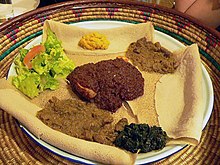Ethiopian cuisine
The Ethiopian cuisine (as well as the cuisine of Eritrea ) differs greatly from the eating habits of both the rest of Sub-Saharan Africa and the oriental region . The staple food is a special sourdough - flatbread called injera . This is ideally made from the native Ethiopian grain teff . However, since teff only thrives well under certain conditions of altitude and climate and is slightly more expensive than other grains, poorer people also bake other grains to make injera. In addition, various sauces, called Wot , are served, which are available in different vegetarian and meat versions. The following applies: Those who can afford it eat meat, with lamb being popular among other things . Pork, on the other hand, is only eaten by missionary Christians because Islam and the Ethiopian Orthodox Church outlaw its consumption.
The Ethiopian Church, like most Orthodox churches, prohibits the consumption of all animal products on Wednesdays and Fridays as well as during the pre-Easter Lent, so that Christians eat lentil or chickpea porridge on these days . In restaurants there are purely vegetarian or vegan dishes on these days, in which different types of beans / peas / lentils are prepared in various combinations. Typical dishes include the vegetable stew Ye Zom Alitscha Wot [Zom -> fast, Alitscha -> mild, Wot -> sauce] or the Sh'ro Wot, a sauce made from broad beans. The right hand is used to eat. The injera replaces the cutlery and at the same time represents the side dish or bread. You just tear off small pieces of the flatbread, take a piece of the meat or vegetable preparation and bring it to your mouth. It is considered particularly friendly to put a portion directly into the mouth of the other participants in the meal (gursha). In general, Ethiopian food is very spicy, mostly with the spice Berbere or Mit Mita . In most Ethiopian restaurants in Europe you can also order milder versions; A spicy, cold-mixed Berbere sauce is often served separately in small bowls.
A particular Ethiopian specialty are dishes made from raw beef . In its simplest form, it is eaten as a tere siga . More upscale versions are Kitfo and Gored Gored .
Ethiopian drinks include Tej honey wine , the simpler millet beer Tella, and country-grown coffee, which is traditionally freshly roasted and served in a special jug ( jabana ).
gallery
Web links
- Ethiopian restaurants in Germany
- Eating and Drinking in Ethiopia (English)
- Spicy dishes from the cradle of civilization (English)
- Article about the Ethiopian raw meat dishes



